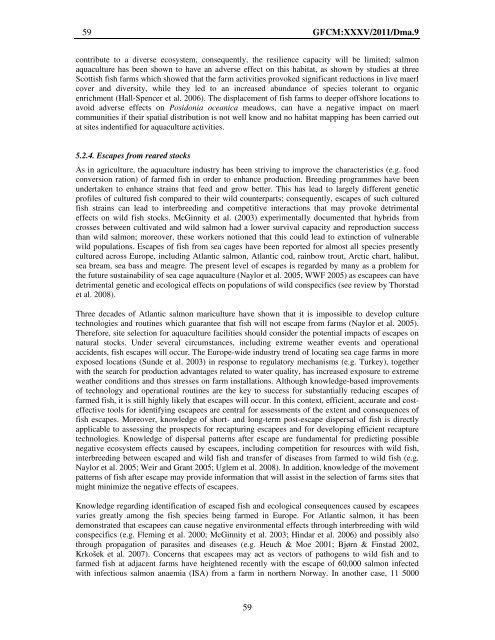Site selection and carrying capacity in Mediterranean ... - FAO Sipam
Site selection and carrying capacity in Mediterranean ... - FAO Sipam
Site selection and carrying capacity in Mediterranean ... - FAO Sipam
Create successful ePaper yourself
Turn your PDF publications into a flip-book with our unique Google optimized e-Paper software.
59 GFCM:XXXV/2011/Dma.9<br />
contribute to a diverse ecosystem, consequently, the resilience <strong>capacity</strong> will be limited; salmon<br />
aquaculture has been shown to have an adverse effect on this habitat, as shown by studies at three<br />
Scottish fish farms which showed that the farm activities provoked significant reductions <strong>in</strong> live maerl<br />
cover <strong>and</strong> diversity, while they led to an <strong>in</strong>creased abundance of species tolerant to organic<br />
enrichment (Hall-Spencer et al. 2006). The displacement of fish farms to deeper offshore locations to<br />
avoid adverse effects on Posidonia oceanica meadows, can have a negative impact on maerl<br />
communities if their spatial distribution is not well know <strong>and</strong> no habitat mapp<strong>in</strong>g has been carried out<br />
at sites <strong>in</strong>dentified for aquaculture activities.<br />
5.2.4. Escapes from reared stocks<br />
As <strong>in</strong> agriculture, the aquaculture <strong>in</strong>dustry has been striv<strong>in</strong>g to improve the characteristics (e.g. food<br />
conversion ration) of farmed fish <strong>in</strong> order to enhance production. Breed<strong>in</strong>g programmes have been<br />
undertaken to enhance stra<strong>in</strong>s that feed <strong>and</strong> grow better. This has lead to largely different genetic<br />
profiles of cultured fish compared to their wild counterparts; consequently, escapes of such cultured<br />
fish stra<strong>in</strong>s can lead to <strong>in</strong>terbreed<strong>in</strong>g <strong>and</strong> competitive <strong>in</strong>teractions that may provoke detrimental<br />
effects on wild fish stocks. McG<strong>in</strong>nity et al. (2003) experimentally documented that hybrids from<br />
crosses between cultivated <strong>and</strong> wild salmon had a lower survival <strong>capacity</strong> <strong>and</strong> reproduction success<br />
than wild salmon; moreover, these workers notioned that this could lead to ext<strong>in</strong>ction of vulnerable<br />
wild populations. Escapes of fish from sea cages have been reported for almost all species presently<br />
cultured across Europe, <strong>in</strong>clud<strong>in</strong>g Atlantic salmon, Atlantic cod, ra<strong>in</strong>bow trout, Arctic chart, halibut,<br />
sea bream, sea bass <strong>and</strong> meagre. The present level of escapes is regarded by many as a problem for<br />
the future susta<strong>in</strong>ability of sea cage aquaculture (Naylor et al. 2005, WWF 2005) as escapees can have<br />
detrimental genetic <strong>and</strong> ecological effects on populations of wild conspecifics (see review by Thorstad<br />
et al. 2008).<br />
Three decades of Atlantic salmon mariculture have shown that it is impossible to develop culture<br />
technologies <strong>and</strong> rout<strong>in</strong>es which guarantee that fish will not escape from farms (Naylor et al. 2005).<br />
Therefore, site <strong>selection</strong> for aquaculture facilities should consider the potential impacts of escapes on<br />
natural stocks. Under several circumstances, <strong>in</strong>clud<strong>in</strong>g extreme weather events <strong>and</strong> operational<br />
accidents, fish escapes will occur. The Europe-wide <strong>in</strong>dustry trend of locat<strong>in</strong>g sea cage farms <strong>in</strong> more<br />
exposed locations (Sunde et al. 2003) <strong>in</strong> response to regulatory mechanisms (e.g. Turkey), together<br />
with the search for production advantages related to water quality, has <strong>in</strong>creased exposure to extreme<br />
weather conditions <strong>and</strong> thus stresses on farm <strong>in</strong>stallations. Although knowledge-based improvements<br />
of technology <strong>and</strong> operational rout<strong>in</strong>es are the key to success for substantially reduc<strong>in</strong>g escapes of<br />
farmed fish, it is still highly likely that escapes will occur. In this context, efficient, accurate <strong>and</strong> costeffective<br />
tools for identify<strong>in</strong>g escapees are central for assessments of the extent <strong>and</strong> consequences of<br />
fish escapes. Moreover, knowledge of short- <strong>and</strong> long-term post-escape dispersal of fish is directly<br />
applicable to assess<strong>in</strong>g the prospects for recaptur<strong>in</strong>g escapees <strong>and</strong> for develop<strong>in</strong>g efficient recapture<br />
technologies. Knowledge of dispersal patterns after escape are fundamental for predict<strong>in</strong>g possible<br />
negative ecosystem effects caused by escapees, <strong>in</strong>clud<strong>in</strong>g competition for resources with wild fish,<br />
<strong>in</strong>terbreed<strong>in</strong>g between escaped <strong>and</strong> wild fish <strong>and</strong> transfer of diseases from farmed to wild fish (e.g.<br />
Naylor et al. 2005; Weir <strong>and</strong> Grant 2005; Uglem et al. 2008). In addition, knowledge of the movement<br />
patterns of fish after escape may provide <strong>in</strong>formation that will assist <strong>in</strong> the <strong>selection</strong> of farms sites that<br />
might m<strong>in</strong>imize the negative effects of escapees.<br />
Knowledge regard<strong>in</strong>g identification of escaped fish <strong>and</strong> ecological consequences caused by escapees<br />
varies greatly among the fish species be<strong>in</strong>g farmed <strong>in</strong> Europe. For Atlantic salmon, it has been<br />
demonstrated that escapees can cause negative environmental effects through <strong>in</strong>terbreed<strong>in</strong>g with wild<br />
conspecifics (e.g. Flem<strong>in</strong>g et al. 2000; McG<strong>in</strong>nity et al. 2003; H<strong>in</strong>dar et al. 2006) <strong>and</strong> possibly also<br />
through propagation of parasites <strong>and</strong> diseases (e.g. Heuch & Moe 2001; Bjørn & F<strong>in</strong>stad 2002,<br />
Krkošek et al. 2007). Concerns that escapees may act as vectors of pathogens to wild fish <strong>and</strong> to<br />
farmed fish at adjacent farms have heightened recently with the escape of 60,000 salmon <strong>in</strong>fected<br />
with <strong>in</strong>fectious salmon anaemia (ISA) from a farm <strong>in</strong> northern Norway. In another case, 11 5000<br />
59
















